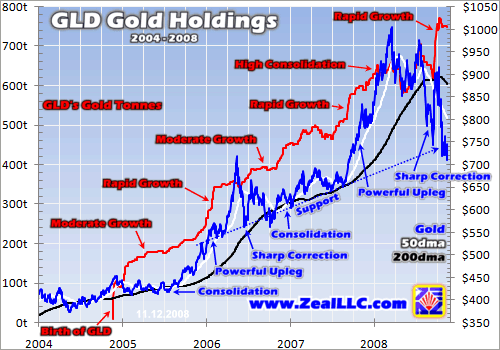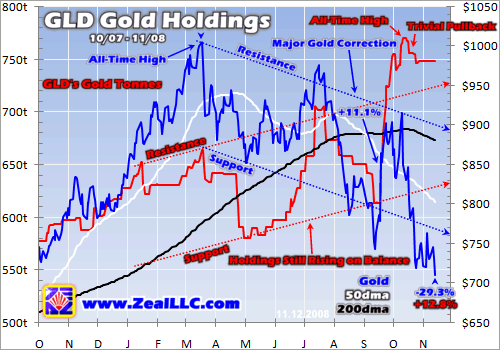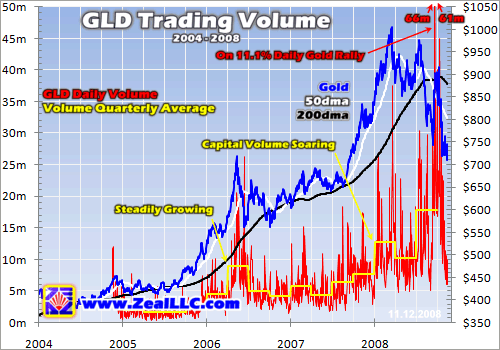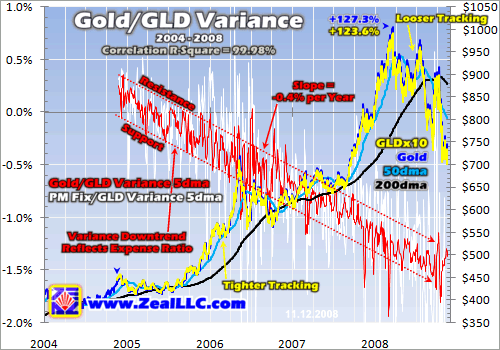|
|
|||||||
|
|
|
|
|
|
|
|
|
|
Gold ETF Impact 4 Adam Hamilton November 14, 2008 3866 Words
Amidst our seemingly endless slog through today’s dark sentiment wastelands plaguing the markets, we have a birthday to celebrate. Four years ago this week, a revolutionary ETF was launched that forever changed trading dynamics within the global gold market. Known today as the SPDR Gold Shares, GLD has been wildly successful by any measure.
GLD’s rise to fame has not been easy. While a few contrarians loved the idea of a gold ETF as a way to broaden investor participation in this gold bull, many investors were very skeptical. Some were downright hostile. Although rehashing all these obstacles GLD has faced is beyond the scope of this essay, I wrote about a gold ETF in 2002 years before GLD hit the market and also GLD itself in early 2006, late 2006, and late 2007. These past essays can still fill you in on GLD’s history and dispel many myths surrounding it.
GLD has overcome much to become not only a juggernaut in the gold world, but in the entire ETF world as well. This week, GLD was the 3rd largest ETF on the planet with $18b worth of net assets (physical gold bullion in its vaults)! Only the SPY S&P 500 ETF and the EFA large-cap foreign stocks ETF were larger. GLD is bigger than the famous QQQQ NASDAQ 100 ETF, the DIA Dow 30 ETF, the XLF S&P 500 financial stocks ETF, and the XLE S&P 500 energy stocks ETF. GLD is huge!
In order to become the 3rd largest ETF in the US out of a universe now exceeding 800, GLD’s custodians have had to execute on their mission exceedingly well. GLD is simply designed to track the price of gold. It grants stock traders an easy and efficient way to add gold exposure to their portfolios. As I’ve discussed extensively in my past GLD essays, it is not a substitute for physical gold coins as the foundation for a long-term investment portfolio. But it’s not meant to be. It is for mainstreamers not well-versed in gold.
GLD’s advantages to traders are legion. It can be bought and sold instantly in any standard stock account, for trivial stock-trading commissions. It can be shorted if one expects a gold correction. A high-volume and highly liquid GLD options market has also sprung up, providing more sophisticated traders with excellent tools to exploit projected gold moves via stock options. GLD is inarguably the easiest and quickest way to get gold exposure.
And GLD’s contribution to this gold bull has been massive as well, driving the gold price higher for all gold investors whether they own GLD or not. It radically widened investor participation in this gold bull, creating a direct conduit for vast pools of stock-market capital to chase gold. And chase gold it has. As of this week, GLD held an amazing 749 tonnes of physical gold bullion in trust for its investors!
This is a staggering amount of the yellow metal and difficult to understand without context. Traditionally, the largest gold holders are the national central banks of the world. Around 100 countries own gold bullion. If you put GLD in this list of elite central banks, it holds more gold today than all but 7! And after it merely grows another 2.1%, GLD will overtake Japan to become the 7th largest gold holder on the planet.
But although GLD is massive in the world of gold, it remains very small relative to the financial markets. With its $18b market cap this week, 118 individual companies in the S&P 500 are each bigger than it. This is even more impressive considering these companies’ market caps were considered from severely depressed end-of-October levels. The top 20% of the S&P 500, the elite S&P 100 companies, collectively had a $5935b market cap at the end of last month. So GLD has plenty of room to grow despite its size.
By acting as a conduit between stock-market capital and physical gold itself, GLD has really changed the dynamics of the world gold trade. There are many other gold ETFs around the world, but GLD has something like 85% of the total assets of all the world’s gold ETFs. It is the only individual gold ETF that really matters. So in this series of essays I have been studying GLD’s ongoing market impact since its launch.
This first chart plots GLD’s holdings since its birth on November 18th, 2004. I like to compare GLD’s gold bullion held in trust with the performance of the price of gold, slaved to the right axis. Not only is multiplying its initial holdings by 94.3x as of mid-October utterly remarkable, but the way these gold holdings have grown is fascinating. They have been far more stable than even GLD’s most optimistic proponents including me originally expected at launch.
While GLD’s holdings have indeed contracted modestly from time to time, its strategic growth trajectory has been tremendously impressive. GLD’s gold has climbed in a somewhat stair-stepped fashion. Of course when gold is surging in a powerful upleg, interest in gold investment is high and GLD grows rapidly. But provocatively even when gold is not surging, GLD still tends to grow moderately on balance.
If you carefully examine every sharp correction suffered by gold above, within them GLD’s holdings really don’t fall all that much on a percentage basis. I would have expected much larger declines during gold corrections when GLD was born. Also interesting is GLD’s behavior during the long, grinding, sideways consolidations in gold that bleed away enthusiasm. It still exhibited moderate growth during these slow times. This performance is stellar, GLD is truly a rock star.
To understand why, consider how tracking ETFs work. To match percentage moves in the price of its underlying asset, a tracking ETF has to see similar supply-and-demand pressures. But supply and demand for GLD shares from stock traders doesn’t necessarily match that of gold futures from futures traders. So in order for GLD to fulfill its mission, GLD’s custodians must actively augment or retard GLD supply to ensure this ETF tracks its underlying asset’s moves tightly. This isn’t easy.
If stock traders demand relatively more GLD than futures traders are buying gold, GLD’s price will decouple from gold to the upside. GLD’s custodians have to vent this excess demand into the physical gold market in order to equalize the demand pressure differential. So when GLD demand exceeds gold demand, they issue new GLD shares and use the proceeds to buy physical gold bullion. This works simultaneously on two fronts. Increasing GLD share supply absorbs the outsized ETF buying pressure and then buying gold with the resulting stock-market capital forces its price to rise more in line with GLD.
So whenever you see GLD’s bullion holdings rise in these charts, it means stock traders were buying GLD at a faster rate than futures traders were buying gold. And as you can see, outside of a few minor pullbacks GLD’s holdings have grown relentlessly. This means GLD is becoming ever-more popular and stock traders are buying it up at a faster rate than underlying gold demand. So GLD must issue shares and buy gold to ensure this ETF keeps tracking gold closely.
Now shunting stock-market capital directly into gold is wonderful when ETF demand is expanding. It has accelerated this secular gold bull. But the massive pools of stock-market capital having access to gold is a sharp double-edged sword. If stock traders ever start selling GLD at a faster rate than gold futures selling, GLD will be forced to contract its holdings. If it doesn’t, GLD will decouple from gold to the downside and fail its mission.
If excessive GLD shares are being dumped on the market and it is falling faster than gold, GLD’s custodians have to buy back this excess supply. Where do they get the cash? By selling gold bullion. This works two ways as well. Selling physical gold forces stock-market selling pressure on GLD into the physical market to equalize the differential. And then using the resulting proceeds to buy back GLD shares neutralizes the excessive ETF selling pressure and keeps GLD tracking gold.
So when (not if) a big disproportionate sustained GLD selloff happens in the future, it will lead to gold falling much faster and farther than it would have if stock-market capital wasn’t deployed in it. Personally I’m glad stock investors can get gold exposure via GLD. Yes, it increases upside and downside volatility. But this is typical as secular bulls evolve. The higher a price goes, the more capital gets interested in chasing it. The more capital flooding into a market, the more volatility it generates. Even without GLD, gold volatility would still gradually increase.
But rather impressively, so far we haven’t seen the massive unwinding of GLD positions that many gold investors understandably fear. GLD’s holdings have grown steadily and relentlessly for 4 years running now. And this has happened through mighty uplegs, wickedly fast and brutal corrections, and long grinding consolidations. As long as demand for GLD continues to grow faster than demand growth for gold itself, GLD will have to continue ramping up its vast holdings.
And with GLD’s holdings running at just 0.2% of the market cap of the S&P 500 at the end of last month, there is lots of room to grow. As more stock investors realize the importance of having some gold exposure in their portfolios, many will buy some GLD shares. At 1% of US portfolios, GLD would have to grow 5x bigger from here. This is not an aggressive or unrealistic expectation within a secular gold bull. At 3% of US portfolios, it would have to expand by 15x. This would make it the world’s largest gold holder by far.
Many hardcore physical-gold-coin investors, including me, have long wondered how GLD owners’ resolve would weather a severe correction in gold. Would they panic and dump GLD, exacerbating the decline in gold? Or would they hold steady? Since GLD is such a trivial part of the aggregate portfolio of all US investors, maybe it is just too inconsequential to bother selling. At any rate, this past year was a great test for GLD owners. Gold was crushed, yet GLD still didn’t see disproportional selling. This chart zooms in.
When gold powered from around $750 in October 2007 to just over $1000 in mid-March, it is no surprise GLD’s holdings were growing. Everyone, especially non-contrarian mainstreamers, loves a hot investment. GLD’s holdings grew to an all-time high of 664 metric tons. But gold cracked on a Fed rate cut surprise (75bp instead of the 100bp expected) in mid-March and plunged 15.3% by early May. Did this spook GLD owners? Darned right it did! Check out the sharp drop in GLD’s holdings over this period.
Since GLD owners were selling this ETF at a faster rate than the futures guys were hitting gold itself, GLD’s holdings fell 12.6% over this span. Having this giant ETF release 1/8th of its physical bullion into the market certainly exacerbated this correction. But interestingly as soon as gold stabilized, so did GLD’s holdings. They held flat near 600t until mid-June when gold started rallying again. Remember that as long as GLD’s supply-and-demand trends match gold’s, no changes in holdings are necessary.
From mid-June to mid-July as Fannie Mae and Freddie Mac were failing, gold powered 12.6% higher. Even though gold itself couldn’t best its $1005 mid-March high, GLD’s holdings easily surged well above their March levels to new records. Over this same 5-week span GLD’s gold bullion held in trust soared by 17.5%! Stock traders were buying GLD far faster than gold itself was rising, so this ETF’s custodian shunted this excess demand into physical gold.
From mid-July to mid-September, gold took a massive 23.8% beating. It was brutal, the worst correction of this gold bull. If there was ever a time for the “weak hands” owning GLD to panic, this was it. And while GLD selling was indeed excessive so its custodians had to sell gold bullion to buy back GLD shares to maintain tracking, GLD’s holdings still only fell 12.5%. This is about half as much as gold fell, not too bad. GLD owners didn’t get as scared as I thought they would in such a massive gold correction.
Gold rallied strongly out of its mid-September lows. In fact, on September 17th it rocketed 11.1% higher on a single trading day! It was one of gold’s biggest daily gains ever in percentage terms. This extraordinary move happening on a day when the S&P 500 fell 4.7% drove tremendous interest in GLD. Stock investors flooded into it at a much faster rate than futures traders were buying gold. That day alone GLD bought 36 tonnes of gold, growing its hoard by 5.9%!
In early October as the financial panic hit, gold got sucked into it. Everything was sold due to margin calls, forced fund redemptions, deleveraging, and fear. Sadly gold was sold as well. I recently wrote an essay on this curious selloff if you are interested. From early October until this week, gold plummeted another 22.4%. If this didn’t terrify GLD owners, nothing will. Here we had a once-in-a-generation financial-market panic and gold failed to soar as expected. Its selloff was a terribly depressing development.
But GLD owners didn’t panic. Their resolve was very impressive. At worst, GLD only had to shed 3.1% of its holdings during this steep gold selloff! Even afterwards this week, GLD’s bullion was still merely near 6-week lows and not far from its all-time high achieved in mid-October. If GLD investors were tough enough not to panic in 2008, a year of extraordinarily brutal and recurring gold selloffs, then I doubt they are a big threat in a more normal gold correction not driven by an exceedingly rare global financial panic.
The net result of all this? Check out the trends on this chart. Gold itself has been in a miserable downtrend since mid-March. It even fell under support in August, September, October, and November. Even long-time hardcore gold investors have had a tough time dealing with this psychologically. Yet despite such a rotten price and sentiment environment, GLD’s holdings have been in an uptrend this past year! Indeed GLD’s holdings soared to new all-time highs twice even after gold had started correcting aggressively.
In recent weeks, GLD’s holdings have been discussed in contrarian circles. If gold fell below a certain price, would GLD owners exit en masse? If they did, gold would plummet of course. GLD would have to shed gold fast to buy excessive GLD share supply. In a worst-case panic scenario, GLD could conceivably dump hundreds of tonnes of gold onto the markets in a matter of weeks. Some have likened it to a “rogue central bank” due to this dire potential.
Is this GLD-as-a-rogue-central-bank-like-selling-vehicle possible? Sure, anything is possible in the markets. But is it likely? Certainly not if 2008’s strong GLD holdings performance truly reflects GLD owners’ resolve. And this makes sense. Despite GLD’s large size relative to gold, it is trivial relative to stocks. An average mainstream investor owns so little GLD that it isn’t even worth worrying about for that particular investor. GLD owners passed 2008’s tough tests with flying colors.
Another way I’ve watched GLD evolve over the years is through its trading volume. The more popular it gets, the more its volume grows. This is true both in terms of absolute share volume and capital volume. Capital volume is price multiplied by share volume. Trading 10m shares of GLD in the $40s is not the same as trading 10m shares of GLD in the $80s. Traders’ interest in and usage of GLD is soaring.
In addition to the raw daily GLD share volume in red, this time I added a quarterly-average-volume line in yellow. This yellow line distills out a lot of the random noise and shows the steady growth of absolute daily volume in GLD. Interestingly it even continued growing on balance in Q2 and Q3 2008 in the midst of gold’s latest correction. Growing volume is a sign of a healthy bull capturing the attention of more and more traders. And of course capital volume is growing even faster than share volume due to gold’s higher prevailing prices over the lifespan of this ETF.
Provocatively GLD had one giant volume spike that wouldn’t fit on this chart. On September 17th it rocketed to 66m shares and the next day it remained incredible at 61m shares. As you can see, this is way beyond GLD’s precedent. What drove this superspike? In past GLD essays, I’ve observed that big gold selloffs can lead to outsized GLD volume spikes. Gold plunges on a given day, GLD traders get scared, and they sell aggressively.
But in mid-September 2008, it was a monster rally that drove GLD volume rather than a selloff. That was the day that gold soared 11.1% in its biggest daily rally in 28 years. This offers another important glimpse into GLD owners’ psyches. When gold soared, enough traders knew about GLD to buy it aggressively. This probably reflects a lot of latent interest in this gold bull among stock traders that is usually overlooked. GLD’s custodians’ performance in keeping GLD tracking gold through such a big and fast surge in demand is very impressive.
This last chart explores the variance between gold itself and GLD. While it seems silly now after 4 years, back in the initial months of GLD’s life naysayers warned it would fail in tracking gold. They thought no one could be nimble enough to actively shunt stock-market capital into and out of gold fast enough to keep an ETF tracking this metal. Thankfully time has proven these fears unfounded, just like most of the other fears surrounding this unique trading vehicle.
Over its entire lifespan, GLD’s daily correlation r-square with gold has run a staggering 99.98%! And yes, this is the r-square and not the raw correlation coefficient itself. It simply could not be any higher. From a stock trader’s perspective, for all intents and purposes GLD’s performance was identical to gold’s. It has fulfilled its mission of tracking gold’s movements perfectly. GLD is a great trading proxy for gold itself.
Early on, GLD tracked gold’s absolute levels more tightly than it does today. The yellow line above is the GLD price multiplied by 10, since each GLD share represents a tenth of an ounce of gold held in trust. As you can see above, this yellow line is falling farther behind the blue gold line as GLD ages. This is totally normal and reflects GLD’s expense ratio. All ETFs charge a small fee for their services, and in GLD’s case this is 0.4% per year.
In return for providing the excellent trading vehicle that GLD has proven to be, its custodians have the right to earn a reasonable profit from their hard work. So each year they sell 0.4% of this ETF’s gold to cover their expenses and earn a profit. This management fee is evident in GLD’s tracking of gold. The red downtrend above shows the 5-day moving average of GLD’s daily variance to gold itself. Its generally tight downtrend proves GLD’s custodians have been doing an excellent job in keeping GLD aligned with gold.
This variance downtrend is the direct result of that 0.4% expense ratio. If you go out 1 year after inception, this downtrend is centered near -0.4%. At 2 years, it is around -0.8%. Not only is 0.4% a year very reasonable for running GLD, there haven’t been any surprises. Like all ETFs, GLD’s net-asset value per share is shrinking slightly every year. But GLD is still deftly fulfilling its mission of tracking gold and providing easy and efficient access to gold exposure for stock-market capital.
Whether GLD is something you own, want to own, or wouldn’t touch with a ten-foot pole because you favor other forms of gold, ultimately it has been very good for this gold bull. All gold investors, regardless of their own investment preferences, want more capital to follow them into gold. We don’t care where this capital comes from, we just want the buying pressure. By creating a conduit between the stock markets and physical gold, GLD has succeeded in radically broadening investor participation in just 4 years.
And as long as this secular gold bull remains intact, GLD should only help gold on balance. The financial panic has driven up investment demand for gold, as GLD’s soaring holdings amidst a falling gold price vividly illustrate. And global mined gold supplies were already falling for years even before gold started correcting and the financial crisis hit. With gold miners’ decimated stock prices and the insurmountable difficulties in getting debt and equity financing today, gold mined supplies’ contraction will accelerate.
On top of this, according to Forbes the US government alone is on the hook for $5 trillion in bailouts so far! Much of this bailout money will be created by the Fed out of thin air and eventually filter into the real economy. And when it does, boy inflation is going to skyrocket. If you think GLD has been popular for the past 4 years, imagine how much more it will be over the next 4 if headline CPI inflation doubles or triples thanks to these asinine socialist bailout schemes? GLD should grow many times over from here.
At Zeal we have long been strategic investors and speculators unswayed by irrational paranoia. Cold hard facts are all that matter, not the endless permutations of wild conspiracy theories. Years before any gold ETF existed, I wrote about how great one would be to broaden gold participation into the mainstream. And since GLD launched, I have fought the many silly myths used to scare investors away from this innovative trading vehicle. GLD has been great for this gold bull!
Today more than ever, investors and speculators need clear thinking and sound analysis untainted by the shrill emotions ruling the day. While the markets are illogical now, they won’t be for long. Panics never persist, but they drive great once-in-a-lifetime bargains that shrewd investors and speculators can capitalize on. If you are tired of being ruled over or unduly influenced by the shifting tides of popular sentiment, join us today. Subscribe to our acclaimed monthly newsletter to grow your market wisdom!
The bottom line is GLD has been a smashing success. By excelling in its mission of tracking gold and providing an easy and efficient way to grant gold exposure to mainstream stock investors, it has grown into the 3rd largest ETF on the planet. And this is even more impressive considering the heavy skepticism and withering attacks on GLD launched from fringe factions within the traditionally pro-gold community.
Whether you or I would own GLD personally or not is irrelevant. The point is many nontraditional gold investors have flocked to GLD and this trend should only accelerate. Broader participation in this gold bull, more capital from more origins bidding up gold, greatly benefits all gold investors. And as 2008 has shown, GLD owners aren’t anywhere near as skittish in a gold selloff as many assumed they would be.
Adam Hamilton, CPA November 14, 2008 Subscribe |
|||||||
|
|
|
|
|
|
|
|
|
|
|
|
|
|
|
|||




